Microbial
Processes > Long-Term Soil Productivity (LTSP) Study > Tour: 2 - Treatments
Standard Forest Treatments (Organic Matter and Compaction)
- C0OM0 - No compaction; low organic removal: trees harvested and bole removed, but slash is left (slash = tops of trees with trunks less than 6 inches in diameter and branches).
- C1OM0 - Medium compaction; low organic removal: trees harvested and bole removed, but slash is left.
- C2OM0 - Heavy compaction; low organic removal: trees harvested and bole removed, but slash is left.
- C0OM1 - No compaction; medium organic removal: trees harvested and bole and slash is removed.
- C1OM1 - Medium compaction; medium organic removal: trees harvested and bole and slash is removed.
- C2OM1 - Heavy compaction; medium organic removal: trees harvested and bole and slash is removed.
- C0OM2 - No compaction; heavy organic removal: total tree and forest floor removal.
- C1OM2 - Medium compaction; heavy organic removal: total tree and forest floor removal.
- C2OM2 - Heavy compaction; heavy organic removal: total tree and forest floor removal.
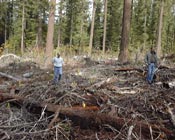 No compaction treatment (C0) (Umpqua LTSP site, OR)
No compaction treatment (C0) (Umpqua LTSP site, OR)
[view medium photo - 120K]
[view large photo - 252K]
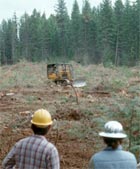 Compaction treatment applied with bulldozer (Priest River LTSP site, ID)
Compaction treatment applied with bulldozer (Priest River LTSP site, ID)
[view medium photo - 68K]
[view large photo - 104K]
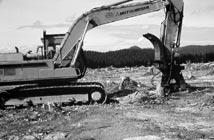 Heavy compaction treatment (C2) applied with tamping plate (LTSP site in British Columbia, Canada)
Heavy compaction treatment (C2) applied with tamping plate (LTSP site in British Columbia, Canada)
[view medium photo - 88K]
[view large photo - 164K]
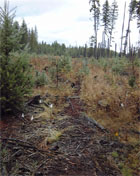 Leaving logs (OM0) - Many sites have vast quantities of downed, decaying logs that have become part of the soil matrix. These logs provide (1) a refuge for fungi, (2) moisture throughout the growing season, (3) carbon sequestration, and (4) a suitable substrate for root growth. (Priest River LTSP site, ID)
Leaving logs (OM0) - Many sites have vast quantities of downed, decaying logs that have become part of the soil matrix. These logs provide (1) a refuge for fungi, (2) moisture throughout the growing season, (3) carbon sequestration, and (4) a suitable substrate for root growth. (Priest River LTSP site, ID)
[view medium photo - 76K]
[view large photo - 160K]
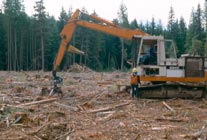 Slash removal (OM1) (Priest River LTSP site, ID)
Slash removal (OM1) (Priest River LTSP site, ID)
[view medium photo - 92K]
[view large photo - 168K]
 Forest floor removal (OM2) by hand with rakes (Council Ranger District LTSP site, ID)
Forest floor removal (OM2) by hand with rakes (Council Ranger District LTSP site, ID)
[view medium photo - 112K]
[view large photo - 212K]
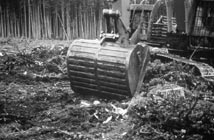 Forest floor removal (OM2) by machine (LTSP site in British Columbia, Canada)
Forest floor removal (OM2) by machine (LTSP site in British Columbia, Canada)
[view medium photo - 88K]
[view large photo - 160K]
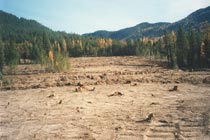 Heavy compaction and forest floor removed (C2OM2) (LTSP site in British Columbia, Canada)
Heavy compaction and forest floor removed (C2OM2) (LTSP site in British Columbia, Canada)
[view medium photo - 108K]
[view large photo - 248K]
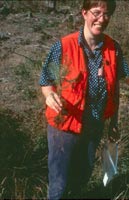 Project leader, Debbie Page-Dumroese with a tree seedlings
Project leader, Debbie Page-Dumroese with a tree seedlings
[view medium photo - 56K]
[view large photo - 92K]
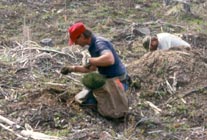 Tree seedlings being planted (Council Ranger District LTSP site, ID)
Tree seedlings being planted (Council Ranger District LTSP site, ID)
[view medium photo - 116K]
[view large photo - 212K]
Optional Extra Forest Treatments (used on selected sites)
- C0/Stumped - Low organic removal: trees harvested, bole and stump removed (stump removal is an attempt to prevent the disease, Armillaria), but slash is left (slash = tops of trees with trunks less than 6 inches in diameter and branches); no compaction.
- Herbicide - heribicide is applied to the understory vegetation on part of a plot and not the rest (the growth rates of trees in both sections are compared - trees on part where herbicide is used will not have to compete as much with other vegetation).
- Winter logging - Logging done in winter in order to compare the effects to those of summer logging (Kamloops, British Columbia, Canada).
 Pulling stumps to prevent the disease, Armillaria (Priest River LTSP site, ID)
Pulling stumps to prevent the disease, Armillaria (Priest River LTSP site, ID)
[view medium photo - 80K]
[view large photo - 124K]
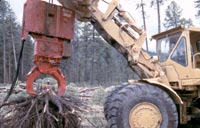 Pulling stumps to prevent the disease, Armillaria
Pulling stumps to prevent the disease, Armillaria
[view medium photo - 60K]
[view large photo - 92K]
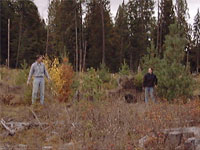 Priest River LTSP installation (no compaction/no organic matter removal) - On left: No herbicide applied. On right: herbicide applied to control competing vegetation. Trees are 2 times larger after controlling competition.
Priest River LTSP installation (no compaction/no organic matter removal) - On left: No herbicide applied. On right: herbicide applied to control competing vegetation. Trees are 2 times larger after controlling competition.
[view medium photo - 64K]
[view large photo - 80K]
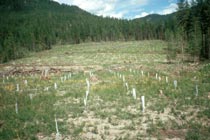 An ameliorative rehabilitation plot (LTSP site in British Columbia, Canada)
An ameliorative rehabilitation plot (LTSP site in British Columbia, Canada)
[view medium photo - 108K]
[view large photo - 228K]
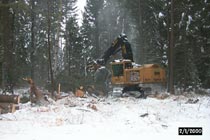 Winter logging (LTSP site in British Columbia, Canada)
Winter logging (LTSP site in British Columbia, Canada)
[view medium photo - 100K]
[view large photo - 200K]
Next Page - Plot Set-up >
















